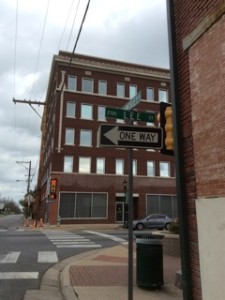
Now we know who Lee was but what about Wesley? While no definite proof is available, it is entirely possible that the street was named for Wesley Methodist Episcopal Church, built on the street shortly after the Civil War. The building in the background was originally named the Medical Arts Building, but after the Henson-Kickernick Company moved their headquarters into the building, it became known as the Henson Building. It’s one of the most elegant structures in Greenville.
Although I have written about Greenville street names in the past, I had a request recently to rehash the subject. First of all, it is important to know that the town of Greenville was located and lots sold in January 1847. No names were given to the streets until about 1880. There was no need for street names; the town was so small everyone knew where others lived and there was no mail delivery service. But in the fall of 1880 the first railroads rolled in and the citizens believed they needed to name their streets to appear more citified.
The four streets surrounding the courthouse were the most important. But there was no one category of names used. On early maps, Lee Street was labeled R. E. Lee. Johnson Street was named for Lyndley Johnson, a noted Indian fighter. Washington, of course, honored President George Washington, revered even in post-Civil War Texas. Stonewall probably was named for Stonewall Jackson. Other Confederate generals honored on Greenville streets were Pickett as in Pickett’s Charge at Gettysburg, and Stuart, probably for J. E. B. Stuart.
Early Greenville men, but no women, were honored with street names. John Gillespie traded his land certificate to James Bourland. Bourland, in turn, traded the land certificate to M. H. Wright who donated land for the townsite, even though he did not have a clear title to the land. Bourland and Wright were early surveyors, while Gillespie probably never set foot in Hunt Count. A Texas land certificate was valid for claim anywhere in the Republic of Texas, and later in the new state of Texas.
Ironically, Davy Crockett who wrote in his diary about a bear hunt near the site of Honey Grove on his way to the Alamo never came close to Greenville. James Polk was the U. S. President who annexed Texas by executive order. Sam Houston was the first president of the Republic of Texas and later governor and senator from the state.
Stevens Street is near Bourland Street. Bourland never lived here but gave his daughter and her husband land north of town. Stevens Street is named for the son-in-law. Oswin King and his family lived where the post office on Lee Street was built. It was Oswin the father and not his son Tom that King Street honored. N. O. Blade was a carpenter, early developer, and son-in-law of Oswin King. John R. Briscoe was a prominent rancher west of town. As a Baptist preacher, he organized First Baptist Church before dying of disease in Arkansas during the Civil War. P. W. Spenser was one of the early mayors, and S. J. Mason served as City Marshall. Langford was also an early settler.
Two major housing developments popped up west and south of downtown in the late 1800s. To the west was Dr. Sayle’s addition. To the south the Moulton Addition added family names of Cornelia and Walworth to our list. Division Street noted the difference between the Moulton Farm and the residential area.
College Street and College Boulevard entered the campus at Burleson College. Stanford Street honored the man who created wonderful gardens in Graham Park before World War II. Of course, Alley and Water Street were little lanes in the industrial area. We know how Katy Street came into being. Eutopia was the tongue-in-cheek joke for a very muddy street in Sayle Addition. But where the names Jordan and St. John came from, who knows?
